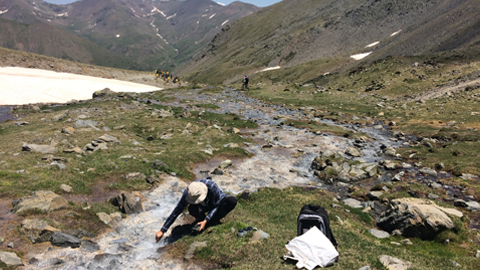Climate change is altering the quality of Pyrenean mountain water

17/07/2019
The acidification of hydrological resources in the Pyrenees is not a problem found only in specific parts of the Central Pyrenees, as believed until now. The problem extends over several areas of the mountain range. These are the conclusions reached by a preliminary study led by the UAB in collaboration with the University of Girona (UdG) and with support from the Ministry for Ecological Transition's Biodiversity Foundation.
The study, directed by Mario Zarroca from the Department of Geology, has enabled researchers to document the most affected river systems and announce the problem to the local and regional administrations.
According to researchers, "our results suggest that climate change is the cause that triggered this phenomenon, since it has been possible to establish a correlation between extended periods of drought and the increase in natural acid-drainage processes”.
The acidification of rivers can be detected due to the turquoise colour of the water and the formation of whitish precipitates rich in aluminium covering the riverbeds.
The researchers highlight the importance of conducting a study at a larger scale with the aim of narrowing down the causes and begin designing preventive and corrective strategies. “The potential toxicity of the metals and metalloids released into the surroundings, such as arsenic, aluminium and nickel, especially through the water, is widely known", researchers point out.
Examples of the aspects of precipitates and water rich in aluminium. Left: Comapedrosa river, Andorra, July 2018. Right: Coma de l'Embut, Núria, September 2018.
Schematic map of the Pyrenean region, indicating the distribution of the main areas in which the natural acid-drainage occurs: 1, Bal del Chistau; 2, Barrancs de Vallibierna and El Ubago (Ésera river) and Vall de Llauset; 3, Arriu Unhòla; 4, Sant Nicolau river; 5, Broate river; 6, Monteixo; Valls de Comapedrosa; 8, Puigmal-Núria and 9 Bastiments-Ull de Ter.
The study “Acidificació de les masses d'aigua d'alta muntanya i la seva relació amb el canvi climàtic, toxicitat i implicacions en la Biodiversitat” (AMiCC) was conducted in several areas of the Natural Parks of Posets-Maladeta (Huesca), Alt Pirineu (Lleida) and the headwaters of the Ter and Freser rivers (Girona).
It was conducted using geomorphological mapping techniques in the fieldwork and the study of multi-temporal series of aerial photos and images, geophysical explorations using electrical resistivity imaging and georadars, as well as through hydrochemical, isotopic and bioindicator sampling, and analysis of climatic series.